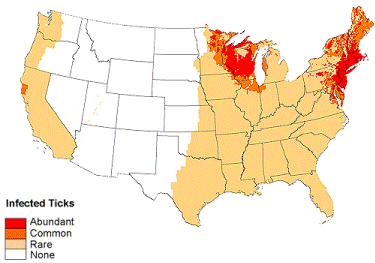Lyme Disease in Dogs
Lyme disease in dogs is actually very preventable, if you live in an area of the country that canine Lyme disease is prevalent (see map below) you may want to consider having your dog vaccinated for Lyme disease.
Lyme disease vaccination in dogs can produce some unwanted side effects with symptoms similar to the disease. With proper tick control and an effective tick repellent along with checking your dog for ticks on a regular basis Lyme disease can be avoided.
 Some best ways to control ticks in and around your yard is to keep your grass mowed, trim and remove brush from your property, trim excess tree limbs allowing the sun better access to your yard, apply a tick killing insecticide to your yard paying special attention to wooded areas.
Some best ways to control ticks in and around your yard is to keep your grass mowed, trim and remove brush from your property, trim excess tree limbs allowing the sun better access to your yard, apply a tick killing insecticide to your yard paying special attention to wooded areas.
Use a tick repellent on your dog. If you would like to try a natural tick repellent visit my
recipes for dog repellent
page. Check your dog for ticks thoroughly when he or she comes in from playing outside, also being sure to check your dog after a visit to the dog park or when your dog is in contact with other animals as it is usually other animals that bring ticks into your environment.
Should you find a tick on your dog visit my
removing ticks from dogs
page for some tips on tick removal. Please note that just because you have found a tick on your dog, this by no way means that she is going to get canine Lyme disease.
It takes the tick 48 hours of being attached to your dog to spread the disease so checking your dog on a daily basis will go a long way to prevent Lyme disease in dogs. For a natural way to support your dogs immune system against canine Lyme disease try TF-Defense this all natural product provides added protection against tick-borne illness.
Although symptoms of Lyme disease in dogs vary and can sometimes take months to present themselves, some of the more common canine Lyme disease symptoms are arthritis and arthritic joints, most often causing tenderness in the front legs near the lymph nodes, the lymph nodes may also be swollen.
Another symptom Lyme disease in dogs is a fever between 102 and 105 degrees with loss of appetite also being common. Your dog may seem to be depressed and have generalized pain with little interest in walking or playing if your dog presents any of these symptoms of Lyme disease, please see your vet for a Lyme disease test and a general physical.
Diagnosis of canine Lyme disease is a relatively simple blood test, should this test come back positive your veterinarian will probably put your dog on a 30 day course of doxycycline (an antibiotic) and may increase the amount of time your dog is treated to 60 days or more if there are signs of kidney problems, if kidney problems are found your vet may include that your dog be on a specialized diet.
Return from Lyme disease in dogs to dog diseases and symptoms

|



 Some best ways to control ticks in and around your yard is to keep your grass mowed, trim and remove brush from your property, trim excess tree limbs allowing the sun better access to your yard, apply a tick killing insecticide to your yard paying special attention to wooded areas.
Some best ways to control ticks in and around your yard is to keep your grass mowed, trim and remove brush from your property, trim excess tree limbs allowing the sun better access to your yard, apply a tick killing insecticide to your yard paying special attention to wooded areas.
